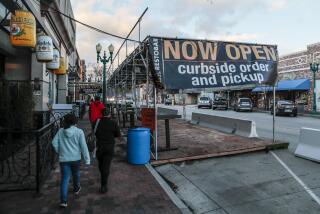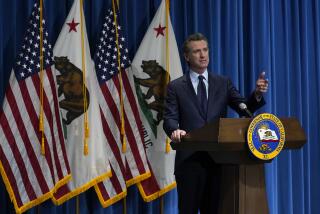Newsom orders new limits on California businesses and activities as COVID-19 soars

California Gov. Gavin Newsom has outlined his administration’s response to the rapid virus spread.
- Share via
SACRAMENTO — Californians will soon be asked to comply with strict limits on community outings, travel and in-person shopping under a statewide order issued Thursday by Gov. Gavin Newsom, a set of new and far-reaching restrictions tied to regional strains on critical care services as COVID-19 cases continue to rise.
The rules, which take effect Saturday, are designed to last for at least 21 days once local critical care facilities approach capacity. But with so many hospitals in the state experiencing a rapid surge of patients with the disease, the “regional stay-at-home” order described by Newsom is likely to limit activities across California throughout the holiday season and possibly into the new year.
“The bottom line is, if we don’t act now, our hospital system will be overwhelmed,” Newsom said in a midday news conference. “If we don’t act now, we’ll continue to see our death rate climb, more lives lost.”
Gov. Gavin Newsom has announced a stay-at-home order affecting most of California.
Despite initial indications that 11 counties in Southern California and 12 counties in the San Joaquin Valley could be required to implement the new restrictions immediately, state health officials later provided a list showing no regions currently at the threshold for closure — meaning no more than 85% of their intensive care unit beds are filled. State officials intend to update the estimates of ICU capacity daily and post the information online.
Once a region’s ICU bed capacity falls below 15%, the shutdown rules will take effect within 24 hours. But with the state’s decision to have the public health order take effect Saturday afternoon, the earliest any region could see closures would be Sunday.
A shutdown affecting the Southern California region would include Los Angeles, Orange, Riverside, San Bernardino, San Diego, San Luis Obispo, Santa Barbara, Ventura, Imperial, Inyo and Mono counties. State officials divided California’s counties into five regions for the purpose of determining intensive care unit capacity and potential shutdowns of local services.
As Californians hunker down for the new restrictions, the nation also is in the worst phase of the pandemic . More than 100,000 people are currently hospitalized with COVID-19 nationwide, the highest national level ever and soaring above the first two waves of the pandemic, according to the COVID Tracking Project. More than 276,000 people have died, according to Johns Hopkins University.
Affected communities will be required to close personal service businesses, including hair and nail salons, playgrounds, zoos, museums, aquariums and wineries. Overnight, short-term stays at campgrounds would be prohibited. Restaurants will be required to return to take-out service only.
Retail businesses will be limited to 20% of their customer capacity inside at any one time, with requirements for store officials to ensure there’s no indoor drinking or eating.
The governor, who remains in quarantine with his family after his children were exposed to people who subsequently tested positive for COVID-19, said the new order is “fundamentally predicated on the need to stop gathering with people outside of your household [and] to do what you can to keep most of your activities outside.”
Los Angeles issued a modified stay-at-home order Wednesday night mirroring new L.A. County rules. “Just be smart and stay apart,” Mayor Garcetti said.
State officials said once a region enters the temporary shutdown, the reopening of closed services and activities will be based on four-week projections of a region’s ICU capacity.
“We recognize the gravity and the importance of the moment and what is being asked of all Californians,” said Dr. Mark Ghaly, secretary of the California Health and Human Services Agency.
Data compiled by The Times show the state has averaged nearly 15,000 cases a day over the last week, triple the rate in the last month. COVID-19 hospitalizations have also tripled over the same period. And an average of 67 Californians were dying daily from COVID-19 over the last week, a 60% jump from mid-November.
State officials are considering the kind of stay-at-home order that helped curb the virus’ spread in the spring. What is unclear is whether Californians will stomach even a modified lockdown as they did in March and April.
Unlike the shutdown Newsom issued in the spring, most outdoor activities, including beach access and hiking, are not affected. But similar to other state government rules, the order allows local leaders to impose public health rules that are more strict. But stronger orders by the state would supersede more permissive local orders. That means the expected implementation of the order in Southern California would require, for example, restaurants to shutter outdoor dining currently allowed in their local jurisdiction.
“This is not a permanent state,” Newsom said.
Strict new limits on shoppers in the run-up to the holiday season could strike a powerful blow to the state’s already hobbled economy. In recent days, Newsom has announced a variety of loan and grant efforts for small businesses as well as the expansion of a program that allows businesses to delay payment of sales tax collections and use the money as a short-term bridge loan.
In most of the state, nonessential retail stores are capped at 25% capacity. Some counties, however, already meet this stricter threshold: L.A. County on Monday lowered its cap on capacity at nonessential retail stores to 20%, and Santa Clara County has limited its cap on nonessential retail to 10% of capacity.
The new restrictions appear to remove the distinction between essential and nonessential retail — a 20% cap on capacity at all stores is likely to significantly reduce capacity at essential retailers, including supermarkets and drug stores. In most of the state, essential stores had been capped at 50% of capacity; in L.A. County, they were capped at 35%; and in Santa Clara County, 25%.
Allan Zaremberg, president of the California Chamber of Commerce, said the loss of revenue at the busiest time of the year could hurt many businesses, including California-based retailers that do not have the same online sales presence as national and international companies.
“The worst thing would be to shut somebody down and it not have any impact on hospital capacity,” Zaremberg said. “For each business that will suffer a revenue loss and fewer employees, it can be catastrophic for them.”
In many ways, the scope of the shutdowns triggered by the dwindling number of ICU beds is broader than many prior efforts.
Cardrooms will be required to shut down, and hotels won’t be allowed to accept tourists.
Entertainment production and professional sports continue to be allowed without a live audience. Santa Clara County, however, on Monday enacted a ban on contact sports, forcing the San Francisco 49ers to temporarily relocate to Arizona for its December games.
One sector of life unchanged by the new rules: K-12 schools. Public school campuses that were allowed to open for at least partial in-person instruction when conditions were better in early fall can remain open.
Some counties or regions could see the restrictions implemented more quickly than required by Newsom’s order. A statement issued late Thursday by Alameda County said it is coordinating with regional partners and noted that while its ICU capacity still exceeds 15%, “if this situation worsens, we may need to enact the State’s Stay-at-Home restrictions before the Bay Area region meets the threshold in order to protect ICU bed availability and save lives.”
Epidemiologists said state officials had no choice but to impose a stricter shutdown to avoid one of the worst public health catastrophes in the state’s modern history, with California’s death toll of nearly 20,000 plausibly doubling by the end of winter.
The initial coronavirus wave “has now become a viral tsunami,” said Dr. Robert Kim-Farley, a medical epidemiologist and infectious disease expert at the UCLA Fielding School of Public Health. “The virus is now everywhere, and so, therefore, the restriction of activities needs to also be applied everywhere to be able to return to where we were — on a decreasing trend.”
Still, the order is likely to exacerbate the frustration of many Californians, especially in trying to better understand how state officials calculate the relative risk of activities such as children using playgrounds and physical distancing in hair salons. While some state lawmakers lashed out at Newsom’s actions as arbitrary, others called for oversight hearings once the Legislature reconvenes next week.
The governor defended Thursday his administration’s actions as rooted in science and public health best practices.
“We want to mitigate mixing, period, full stop,” he said. “We want to diminish the amount of mixing. And we really need to send that message broadly. And we need to create less opportunities for the kind of contact and extended period, extended time of contact, that occurs in many of these establishments.”
Times staff writers Taryn Luna, Luke Money and Iris Lee contributed to this report.
More to Read
Sign up for Essential California
The most important California stories and recommendations in your inbox every morning.
You may occasionally receive promotional content from the Los Angeles Times.















